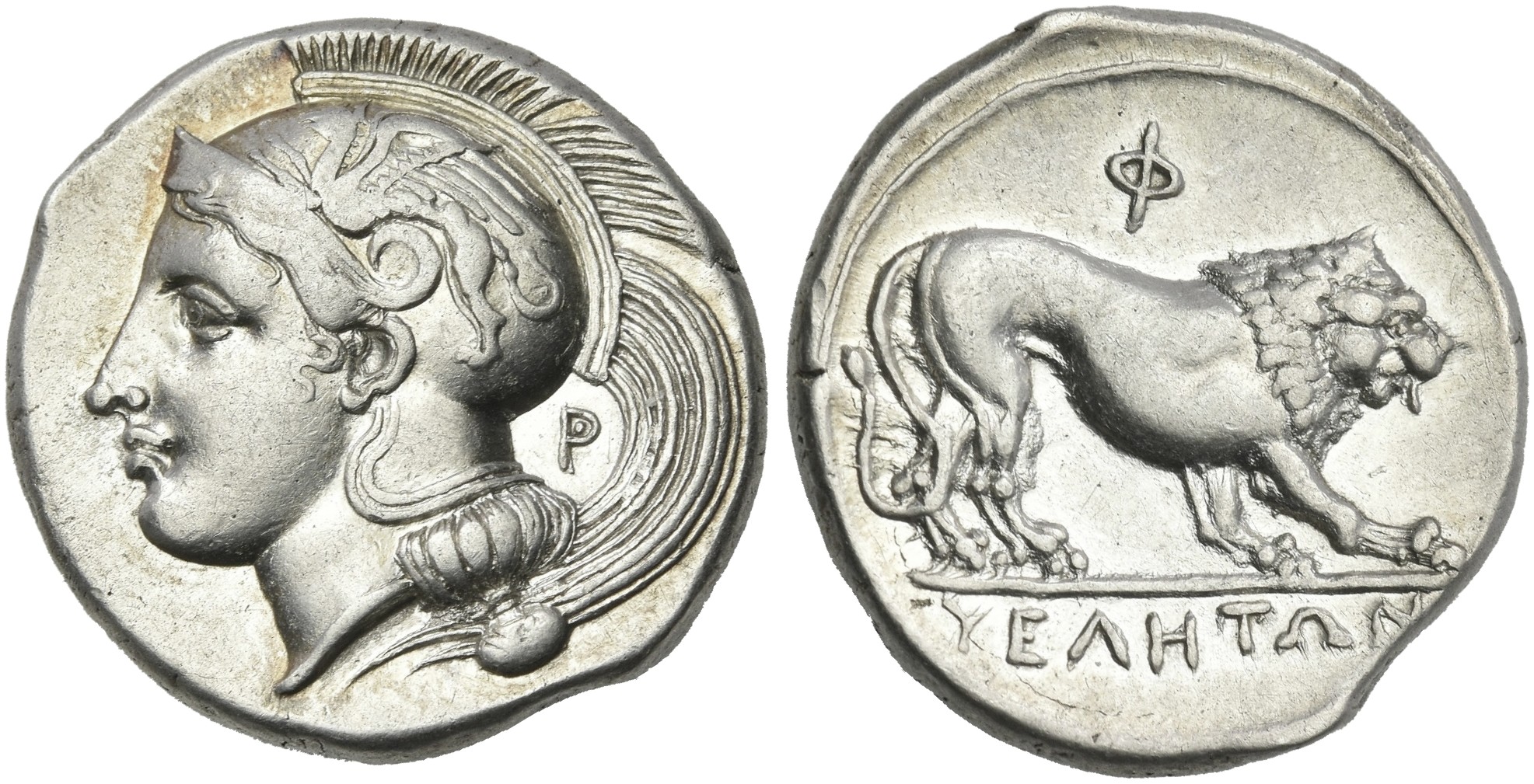Velia, silver, didrachms (365-340 BCE)
From SILVER
365 BCE - 340 BCE Silver 2,508 kg
Description
| ObverseInscription or printing placed on the obverse.: | Head of Athena right or left, wearing helmet. Behond, Q. |
| ReverseInscription or printing placed on the reverse.: | YEΛHTEΩN (Greek).Lion walking r., above, Φ |
Mint and issuing power
| MintIdentifies the place of manufacture or issue of a numismatic object.: | Velia | Ancient regionAncient region.: | Lucania | Modern countryModern country: Italy | AuthorityIdentifies the issuing power. The authority can be "pretended" when the name or the portrait of X is on the coin but he/she was not the issuing power. It can also be "uncertain" when there is no mention of X on the coin but he/she was the issuing power according to the historical sources: |
Chronology
| FromIdentifies the initial date in a range assigned in a numismatic context. | 365 BCE | toIdentifies the final date in a range assigned in a numismatic context.. | 340 BCE | PeriodTime period of the numismatic object.: Classical 480-323 BC |
Physical description
| MetalThe physical material (usually metal) from which an object is made.: | Silver |
Median weightMedian of the weights of numismatic objects (in grams). in grams | 7.65 | DenominationTerm indicating the value of a numismatic object. Examples: tetradrachm, chalkous, denarius.: | didrachm |
StandardStandard.: |
Image

AC 16 - Velia, silver, didrachm, 365-340 BC.jpg [1]
References
| Die study referencePublication of the study: | Williams 19921Williams 1992, groupe V : variétés 251-296 (D148bis-D164 et R198-R228) | ||
| Coin series referenceReference to coin series study: | Sear I2Sear I, n° 454, RQEMAC3RQEMAC, n° 16, HN Italy4HN Italy, n° 1284, HGC 15HGC 1, n° 1310 | ||
Obverse dies distribution
| FrequencyFrequency of specimen in distribution. ᵖ | Number of obversesNumber of obverse dies. ᵖ (o) | % (o) | Number of coinsNumber of coins. (n) | % (n) | Die nameName(s) of the die(s). |
| 1 | 1 | 5.88 | 1 | 0.22 | 161 |
| 3 | 1 | 5.88 | 3 | 0.66 | 156 |
| 7 | 1 | 5.88 | 7 | 1.55 | 160 |
| 11 | 1 | 5.88 | 11 | 2.43 | 159 |
| 15 | 1 | 5.88 | 15 | 3.32 | 150 |
| 16 | 2 | 11.76 | 32 | 7.08 | 157, 163 |
| 18 | 1 | 5.88 | 18 | 3.98 | 158 |
| 20 | 1 | 5.88 | 20 | 4.42 | 164 |
| 25 | 1 | 5.88 | 25 | 5.53 | 148bis |
| 26 | 1 | 5.88 | 26 | 5.75 | 155 |
| 41 | 1 | 5.88 | 41 | 9.07 | 149 |
| 43 | 1 | 5.88 | 43 | 9.51 | 162 |
| 45 | 1 | 5.88 | 45 | 9.96 | 154 |
| 46 | 1 | 5.88 | 46 | 10.18 | 153 |
| 48 | 1 | 5.88 | 48 | 10.62 | 152 |
| 71 | 1 | 5.88 | 71 | 15.71 | 151 |
| Total | 17 of 17 | 99.96 | 452 of 452 | 99.99 |
Reverse dies distribution
no distribution is available
Quantification
| Number of obversesNumber of obverse dies. ᵖ (o) | 17 | Number of singletons (o1)The number of singleton coins. ᵖ | 1 |
| Number of reverse diesNumber of reverse dies. (r) | 31 | Number of coinsNumber of coins. (n) | 452 |
| Coins per obverse dieNumber of coins per obverse die. (n/o) | 26.59 | Coins per reverse dieNumber of coins per reverse die. (n/r) | 14.58 |
| Reverse per obverse ratioRatio of obverse dies divided by reverse dies. (r/o) | 1.82 | Percentage of singletons (o1)number of coins (n) divided by the number of singletons (o1) ᵖ | 5.88 % |
| Original number of dies (O) (Carter 1983 formula)The estimation of the number of coins according to Carter 1983 ᵖ | 16.39 | Coins struck if 20,000 as average productivity per dieCoins made if the average productivity for obverses (according to Carter) is 20,000. ᵖ | 327,800 |
| Original number of dies (O) (Esty 2011 formula)The estimation of the number of coins according to the singleton formula in Esty 2011 ᵖ (O) | 17.66 | Survival rate if 20,000 as average productivity per dieSurvival rate if average productivity is 20,000. ᵖ | 0.00138 |
| Coverage (o = % of O) (Esty 1984 formula)Esty 1984 - coverage (% of O) ᵖ (o = % of O) | 99.78% | Die productivity if survival rate 1/2,000Average productivity if survival rate is 1/2,000. ᵖ | 55,155.58 |
| Weight of silver (in kg) if 20,000 coins per die (O = Carter formula)Carter 1983 * Median weight * 20000 (*10 if gold or electrum) ᵖ | 2,508 kg <br /> 2,508 kg | Die productivity if survival rate 1/5,000Average productivity if survival rate is 1/5,000. ᵖ | 137,888.96 |
Remarks